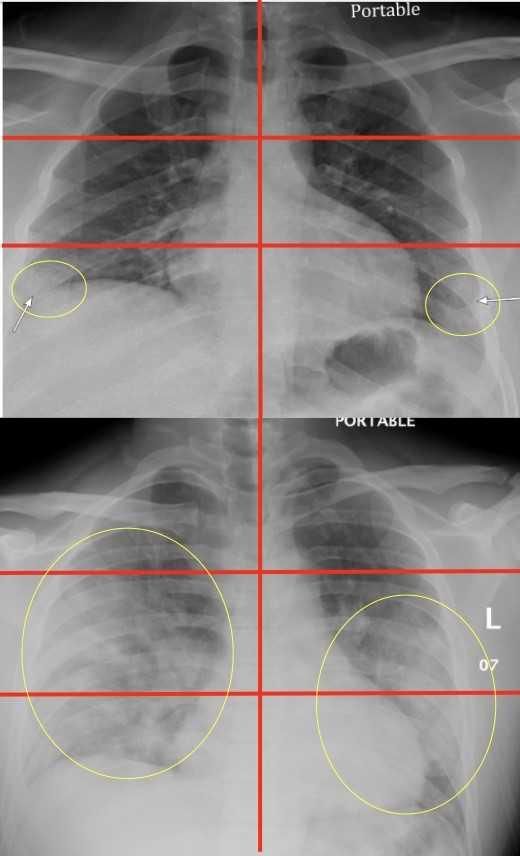Chest X-rays Can Predict COVID-19 Severity in Young and Middle-Age ER Patients
X-ray classification system developed at Mount Sinai can help identify patients who will most likely need hospitalization and intubation.

Although the Centers for Disease Control & Prevention has recommended against using chest X-ray for COVID-19 diagnosis, new research has revealed the scans, when performed on young and middle-aged adults in the emergency room, can effectively predict which patients with the virus will be at higher risk for developing more severe illness and requiring intubation.
Published today in Radiology, this first-of-its-kind study pinpoints the patients who will likely need to be hospitalized and put on a ventilator according to the severity of the coronavirus patterns seen in the lungs via X-ray. Researchers from Mount Sinai developed a unique scoring system to assess severity, and they said physicians could use the results for quicker identification, triage, and treatment for these high-risk patients.
“This is the first study looking at how we can use chest X-rays from the emergency room to predict how sick COVID-19 patients will get,” said first study author Danielle Toussie, M.D., a resident in the Icahn School of Medicine at Mount Sinai radiology department. “We demonstrate how valuable X-rays can be during this pandemic because, by evaluating disease in different portions of the lungs, we can predict outcomes, which can potentially help appropriately allocate resources and expedite treatment in the most severe cases.”
The team developed the scoring system to help referring clinicians better understand what the scan findings mean for individual patients, she said.
“We would tell [clinicians], ‘We see this opacity here or that opacity there,’ but, then, they would ask, ‘What does that mean for my patient?’” Toussie said. “That’s what we set to find out, and we started noticing that while most patients had disease in the lower lobes only, the patients who had multiple areas of disease, or disease in the upper lobes, seemed to be doing worse.”
Consequently, their classification system divided up the lungs, scored them for severity of disease, and correlated that with what the patients actually experienced as the disease progressed or resolved.
To devise the system, the team evaluated the records of 338 COVID-19-positive patients, between the ages of 21 and 50, at The Mount Sinai Hospital and Mount Sinai Brooklyn between March 10 and March 26. The average age was 39, and 62 percent were male. In the records review, investigators looked at race, pre-existing conditions, including asthma, diabetes, hypertension, HIV, and obesity. Additionally, each patient underwent a chest X-ray in the emergency room.
Researchers examined the patterns of coronavirus in the lungs of every patient, identifying the opacities and where those patterns were located. They divided the X-rays into six zones – upper right, upper left, middle right, middle left, lower right, and lower left. They also created a 0-to-6 scoring system to quantify severity. They considered scores between 0 and 2 to be lower severity and between 3 and 6 to be higher severity. Mount Sinai’s cardiothoracic radiologists have already implemented this scoring system to help emergency physicians appropriately classify patients.
Overall, 145 patients included in the study were admitted to the hospital. The researchers determined that those with the highest severity scores were 6.2 times more likely to require hospitalization and 4.7 times more likely to be intubated. Men were more likely to have higher chest X-ray scores and to be admitted. However, they were not more likely to be intubated. Additionally, obese patients were also more likely to have higher severity scores and to require hospitalization.
Specifically, this is how the patients scored:
- 0: 34 patients, 2 intubations
- 1: 15 patints, 1 intubation
- 2: 38 patients, 6 intubations
- 3: 14 patients, 2 intubations
- 4: 32 patients, 10 intubations
- 5: 7 patients, 3 intubations
- 6: 5 patients, 4 intubations
Although previous reports have indicated worse outcomes among African American and Latino patients, the researchers said this study showed there was no significant difference in outcomes between patients of different races and ethnicities when findings were adjusted for other factors, including age, gender, co-morbid conditions, and weight.
According to co-author Yogesh Sean Gupta, M.D., Icahn associate professor of diagnostic, molecular, and interventional radiology, the study results provide insight into how younger individuals – who make up a good proportion of affected patients – may ultimately fare. That knowledge can help providers efficiently gather and implement necessary treatment resources.
Senior author Adam Bernheim, M.D., Icahn assistant professor of diagnostic, molecular, and interventional radiology, agreed.
“These findings underscore how COVID-19, despite its many manifestations, is largely a respiratory illness and the lung changes identifiable on X-ray are a primary predictor of disease progression,” he said. “This work is foundational for demonstrating the role of radiology not only in diagnosis, but also in predicting, triaging, and risk-stratifying COVID-19 patients so that those at highest risk for severe disease can be immediately identified from the moment of the very first chest X-ray upon presentation.”